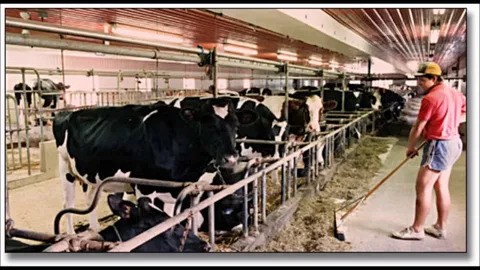US Dairy Farm Worker Jobs
The United States is the world’s second-largest dairy producer, generating over 226 billion pounds of milk annually from its 24,000+ licensed dairy farms. Behind this massive industry are dairy farm workers—the hands-on laborers who care for cows, manage milking operations, and maintain the facilities that keep America’s refrigerators stocked with milk, cheese, and yogurt. While the job is physically demanding and often underappreciated, it offers steady employment, opportunities for skill development, and a vital role in sustaining rural economies. This guide explores the realities of dairy farm work in the US, including job duties, income potential, challenges, and pathways to advancement.
The Role of a Dairy Farm Worker
Dairy farm workers are responsible for the day-to-day operations that ensure the health and productivity of dairy herds. Key tasks include:
- Milking Cows: Operating automated milking systems or performing manual milking (less common today).
- Feeding and Nutrition: Preparing and distributing feed, monitoring diets, and ensuring clean water access.
- Animal Health: Checking cows for illnesses, administering medications/vaccines, and assisting with calving.
- Herd Management: Moving cows between pastures, pens, and milking parlors; maintaining hygiene to prevent disease.
- Equipment Maintenance: Cleaning milking machines, repairing fences, and servicing tractors or feed mixers.
- Record-Keeping: Tracking milk production, breeding cycles, and medical treatments using digital tools.
Work Environments:
- Family-Owned Farms: Small to mid-sized operations where workers handle diverse tasks.
- Large Commercial Dairies: Industrial facilities with hundreds or thousands of cows, often using advanced automation.
- Organic Dairy Farms: Focused on pasture-raised cows and USDA-certified organic practices.
Shifts often start before dawn and may include weekends, as cows require milking 2–3 times daily. The job demands physical stamina, adaptability to weather extremes, and comfort working around animals.
Demand for Dairy Farm Workers in the US
Despite automation, dairy farming remains labor-intensive, with steady demand driven by:
- Consumer Demand: Americans consume over 650 pounds of dairy per person annually.
- Export Markets: The US exports $7 billion worth of dairy products yearly, requiring high production volumes.
- Rural Workforce Gaps: Native-born workers increasingly leave agricultural jobs, creating reliance on immigrant labor.
- Specialized Roles: Larger farms need technicians for robotics, herd data analysis, and sustainability initiatives.
According to the USDA, the dairy sector employs over 150,000 workers directly, with states like California, Wisconsin, Idaho, Texas, and New York leading in production. However, labor shortages persist, with farms struggling to fill 15–20% of positions annually.
Requirements and Qualifications
Most dairy farm jobs are entry-level but require specific skills and certifications:
- Education: No formal degree needed, though a high school diploma or GED is preferred.
- Experience: Prior work with livestock (even on family farms) is advantageous.
- Physical Fitness: Ability to lift 50–100 pounds, stand for hours, and work in muddy or icy conditions.
- Technical Skills: Operating milking machinery, tractors, or computerized herd management systems.
- Certifications:
- OSHA Safety Training: For handling equipment and chemicals.
- CDL License: Required for workers transporting milk or animals.
- AI (Artificial Insemination) Certification: Useful for breeding roles.
Bilingual skills (English/Spanish) are valuable, as 50–80% of dairy workers are immigrants, primarily from Mexico and Central America.
Salary Expectations for Dairy Farm Workers
Wages vary by farm size, location, and role:
- Average Hourly Pay (2023):
- Entry-Level Workers: 13–17/hour
- Experienced Workers: 18–25/hour
- Specialized Roles (e.g., Herd Manager): 25–35/hour
Annual Earnings:
- Full-time workers typically earn 30,000–50,000/year.
- Managers or technicians at large dairies can make 60,000–80,000.
Additional Benefits:
- Housing: Some farms provide on-site housing (a 5,000–10,000 annual value).
- Health Insurance: Offered by 40% of large farms, per the National Milk Producers Federation.
- Overtime Pay: Federal law mandates 1.5x wages after 40 hours/week, though small farms (under 500 cows) may be exempt.
Challenges of Dairy Farm Work
The job’s demands can be grueling:
- Physical Strain: Repetitive motions lead to chronic injuries (e.g., back pain, carpal tunnel).
- Long Hours: 10–12 hour shifts, 6 days/week during peak seasons.
- Emotional Stress: Bonding with animals while managing culling or stillbirths.
- Weather Extremes: Summer heat and winter cold in open-air barns or pastures.
- Economic Pressures: Low milk prices and rising feed costs force some farms to cut wages.
Benefits and Perks
Despite challenges, dairy work offers unique rewards:
- Job Stability: Farms operate year-round, unlike seasonal crop agriculture.
- Skill Development: Learn animal husbandry, mechanics, and agri-tech.
- Rural Lifestyle: Work outdoors in tight-knit farming communities.
- Immigrant Opportunities: Many farms sponsor H-2A visas or help workers pursue citizenship.
Career Advancement Opportunities
With dedication, workers can climb the ladder:
- Herd Manager: Oversee animal health, breeding, and milk quality.
- Equipment Technician: Specialize in maintaining robotic milkers or feed systems.
- Farm Supervisor: Manage teams and daily operations.
- Dairy Consultant: Advise farms on efficiency or sustainability.
- Farm Ownership: Transition to running a small dairy (requires significant capital).
Advanced roles often require certifications in dairy science (offered by universities like Cornell or UW-Madison) or veterinary assistance.
The Future of Dairy Farm Jobs
Innovations are reshaping the industry:
- Robotics: Automated milkers (e.g., DeLaval Voluntary Milking Systems) reduce manual labor but require technicians.
- Precision Farming: Sensors track cow health metrics (e.g., rumination, activity), creating roles in data analysis.
- Sustainability Initiatives: Methane-reduction technologies and organic practices open niche markets.
- Vertical Integration: Large cooperatives (e.g., Dairy Farmers of America) streamline careers in logistics and marketing.
Workers willing to adapt to tech and eco-friendly practices will remain competitive.
How to Apply for Dairy Farm Jobs
- Job Boards: Search Indeed, AgCareers.com, or DairyHerd.com.
- Local Networks: Contact county extension offices or state dairy associations (e.g., Wisconsin Dairy Business Association).
- Immigrant Pathways: Connect with agencies like Catholic Charities for H-2A visa placements.
- Apprenticeships: Programs like Vermont Dairy Apprenticeship offer paid training.
Resume Tips: Highlight animal care experience, machinery skills, and reliability.
Legal Rights and Protections
- Fair Labor Standards Act (FLSA): Guarantees minimum wage ($7.25/hour) and overtime for eligible workers.
- Worker Protection Standards: OSHA enforces safety rules for equipment and chemical use.
- H-2A Visa Protections: Requires farms to provide housing, transportation, and fair wages for migrant workers.
Living as a Dairy Farm Worker
- Cost of Living: Lower in rural areas (e.g., 800–1,200/month rent in Wisconsin).
- Community Support: Many farming towns offer ESL classes, healthcare clinics, and cultural events.
- Work-Life Balance: Shifts often start early but end by afternoon, allowing family time.
US Dairy Farm Worker Jobs
Dairy farm work in the US is not just a job—it’s a commitment to sustaining an industry that nourishes millions. While physically tough and economically volatile, it offers unmatched opportunities for those passionate about agriculture and animal care. As technology transforms the sector, workers who embrace innovation and sustainability will find themselves at the heart of a resilient, evolving field. Whether you’re a local seeking rural stability or an immigrant building a new life, dairy farming remains a cornerstone of America’s agricultural legacy.



